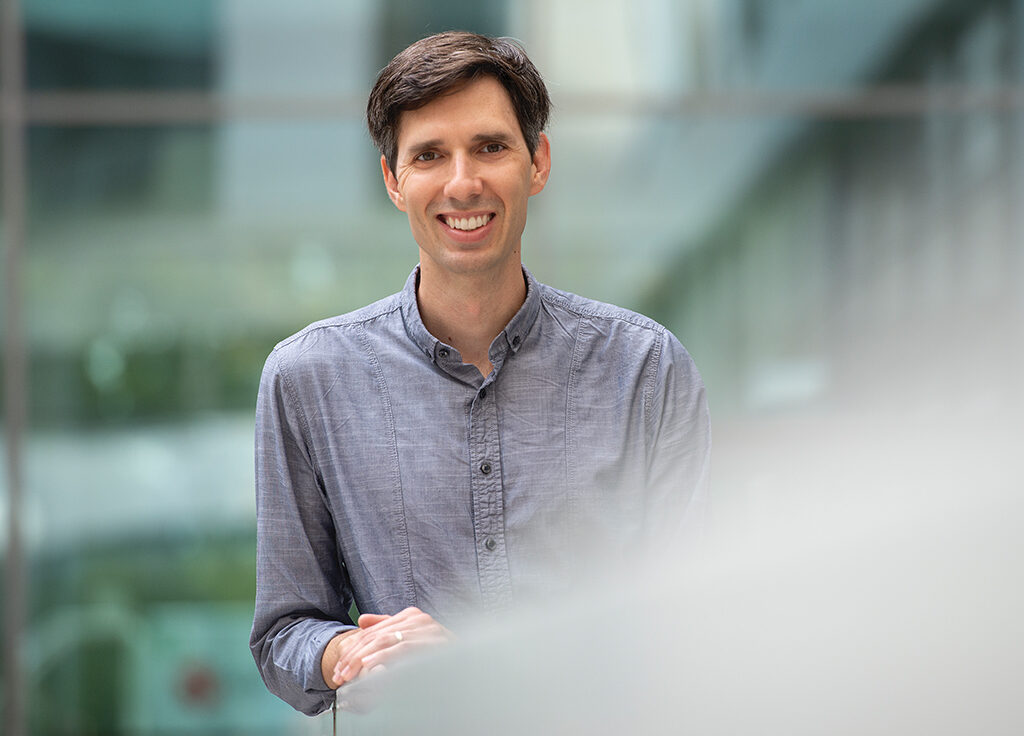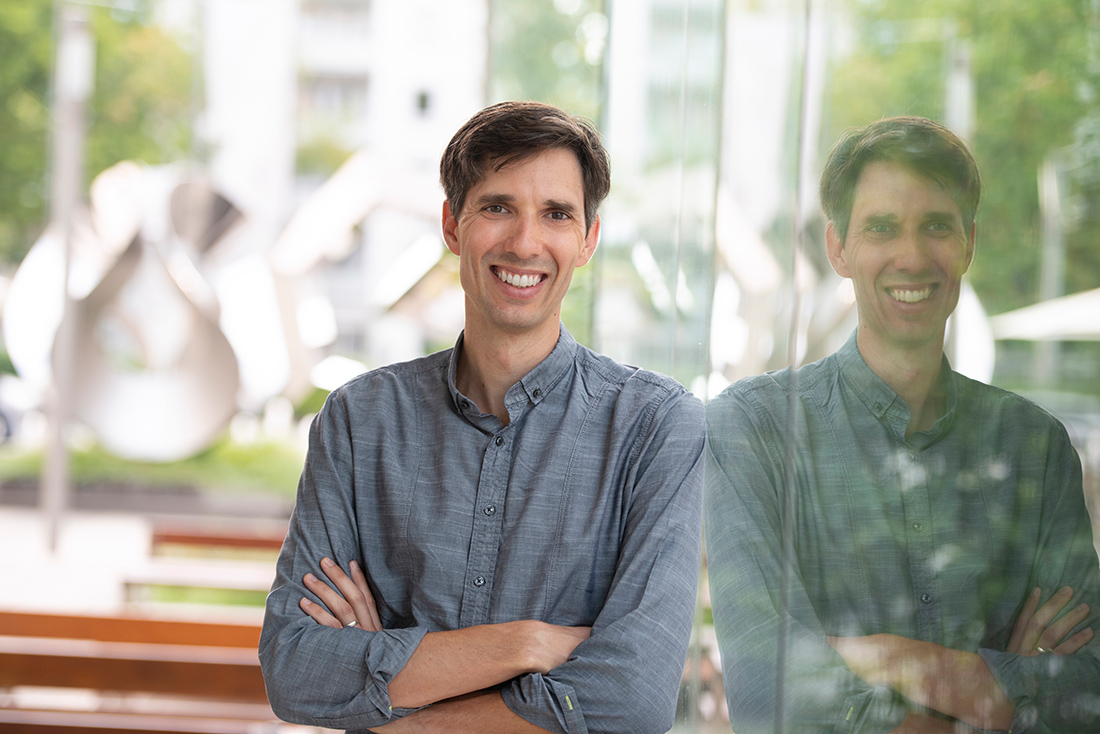)
Then we would have a kind of plug-and-play construction kit.
German version/Deutsche Version
Dominik Niopek claims that biology is potentially the most powerful discipline in engineering. But he doesn’t just claim it. He’s also well on his way to proving that claim. “My goal is to precisely control cells in their behavior,” Niopek says. Control in the sense of monitoring is predominantly for research purposes. “I monitor a certain cellular process and observe what result it leads to, so I learn something about it.” Control in the sense of steering, on the other hand, is already application-oriented; it directs the cell’s behavior in a particular direction to achieve a desired state, much like driving a car to a known destination. Dominik Niopek uses proteins as tools and motors of this control, respectively. A natural choice, because proteins are both the stabilizers and playmakers of life. His main field is optogenetics, which exploits the property of photosensory proteins to react to light pulses. Based on this, he has constructed special proteins that can be controlled by light or drugs in such a way that he can use them to switch the process of genome editing on or off at short notice at will. The extent to which his constructive skills as a synthetic biologist are appreciated is demonstrated by the fact that he has been appointed to the Chair of Pharmaceutical Biology at the newly founded Faculty of Engineering Sciences at Heidelberg University, where he has returned to from Darmstadt Technical University, in the summer semester of 2023.
The courage to enter a new field
The foundations of optogenetics were laid in 1971 with the discovery that the ion pump bacteriorhodopsin can be activated by light. For four decades, this discovery then remained in the drawer of scientific knowledge until 2003, when the ion channel channelrhodopsin-2 (ChR2) was isolated from green algae. This ion channel opens when blue light falls on the alga, enabling it to orient itself optimally toward the sun, from where it obtains the energy for photosynthesis. After the gene for ChR2 was successfully transplanted into a nematode and into nerve cells from rats three years later, optogenetics took off. This was because the nerve cells could now be stimulated by irradiation with blue light in such a way that its muscles contracted, and it moved in desired directions. This generally opened up the possibility of intervening in natural processes without chemical stimuli, touch stimuli or invasive methods. Consequently, the journal Nature Methods crowned optogenetics as method of the year in 2010. At this time, Dominik Niopek was in the middle of thinking about his upcoming master’s thesis while studying molecular biotechnology in Heidelberg. He courageously decided on a topic from the new field of optogenetics. He liked it so much that he not only remained true to optogenetics in his subsequent doctoral thesis in the Department of Bioinformatics at the German Cancer Research Center under the supervision of Roland Eils, but also significantly advanced the development of the field.
Freedom optimally used
Roland Eils had already been impressed by Dominik Niopek, when he was a bachelor’s student. After all, he had been part of his first student team at the international Genetically Engineered Machine (iGEM) competition held at the Massachusetts Institute of Technology in 2008 and had contributed a great deal to its success. As a result, Eils accepted Niopek as a graduate student, even though optogenetics was completely new to his department. Niopek was fully responsible for his projects from the beginning, Eils says, “from creative planning to experimental implementation to data analysis.” And Niopek emphasizes that in Roland Eils he found a mentor “who could look at my projects from a higher perspective and gave me maximum freedom for my research right from the start.” Niopek knew how to use this freedom: The results of his doctoral thesis led to two top publications in Nature Communications – and for good reason. [1][2] The doctoral student had used optogenetic control for the first time for the intracellular transport of proteins between the cytoplasm and the cell nucleus.
A tool for research
To do this, he used the light-sensitive protein LOV from the oat plant, which is part of its sunlight sensor phototropin. “LOV is compact and rigid in the dark but changes its structure so much when exposed to light that it partly unfolds during this process,” Niopek explains. “Its small size and flexibility make it ideal for protein targeting.” To prove the feasibility of his concept, Niopek first linked LOV to a kind of address label that recommended it to the cell’s natural transport system as an important cargo for the cell nucleus. He then coupled the genetically engineered protein to a red fluorescent reporter protein. If he now irradiated the cells in which he had made these preparations with blue light, a protein shuttle from the cytosol to the cell nucleus immediately began. Within a few seconds, the cell nucleus turned red. Starting from this proof of concept, Niopek succeeded in tagging important transcription factors such as p53 or NFKB with the modified LOV label instead of the reporter protein. If he now illuminated the cells with blue light, they started genetic repair programs or divided. “For research in cell cultures and model organisms, this method has become an important tool,” Niopek says. “However, they are still far from suitable for light-guided cancer therapy in humans.”
Light switch for genome editing
After Niopek’s doctoral thesis confirmed his scientific brilliance, Roland Eils offered him a position as junior research group leader for synthetic biology in 2016. In the meantime, a genome editing method had begun its triumphant march through laboratories around the globe that was far superior in its simplicity, accuracy and cost-effectiveness to the methods previously used with zinc finger and TALE nucleases. It was based on the targeted dispatch of the nuclease Cas9 to an arbitrarily definable site on the DNA. In 2015, it was named Breakthrough of the Year by the journal Science. Emmanuelle Charpentier and Jennifer Doudna launched this CRISPR-Cas process in 2012, using a bacterial defense system against viruses (bacteriophages) as a model. Viruses, in turn, defend themselves against bacterial Cas gene scissors with the help of anti-CRISPR proteins. “When I set up my own lab in Heidelberg, the first papers on these viral inhibitors of Cas nucleases had just been published,” Dominik Niopek recalls. And he soon knew how to turn this news into a remarkable innovation. Namely, he and his team constructed light-switchable anti-CRISPR proteins, in an approach for which he chose the eloquent acronym CASANOVA (CRISPR-Cas activity switching by a novel, optogenetic variant of anti-CRISPR proteins).[3] He again chose the LOV protein from the oat plant as the switchable photoreceptor. “Switchable anti-CRISPR proteins can be combined with all CRISPR editors that are available,” Niopek says.” Depending on which cells in a culture or tissue you illuminate, you can use it to precisely limit genome editing locally. Therapeutically, this could one day make it possible to specify exactly which cells a CRISPR-Cas nuclease should act in. “In patients with genetic diseases of the skin and especially the retina, for example, it would then be possible to edit the genome exclusively there by light control,” Niopek explains. In principle, however, such control is also possible by coupling with receptors for messenger substances that are specific to a certain cell type. In the future, it might even be possible to treat hereditary muscle atrophy in this way.
Plug and play with proteins
As more relevant than precise localization, however, Niopek regards the temporal differentiability of genomic interventions thanks to switchable nucleases. Especially for research purposes. For example, he is cooperating with a neuroscientist in Lausanne who has discovered a gene that presumably plays an important role in the process of learning. Niopek is now providing him with an optogenetic tool with which he can quickly switch this gene on or off in mice at any time. This may make it possible to determine in which phase of the learning process this gene must be active. At the basic research level, however, Niopek says he is less interested in how cells work. Rather, he says, his main interest is in controlling processes by precisely influencing the proteins involved in them. “I want to take what we did with anti-CRISPR proteins and apply it to all kinds of other proteins.” That’s easier said than done, because it currently takes one to two years for a graduate student to succeed in building a well-functioning anti-CRISPR switch. “It would be fantastic if we could scale this up,” Niopek says. “Then we would have a kind of plug-and-play construction kit for switchable proteins.”
A promising combination
On the way to this construction kit, the prize money associated with the Life Sciences Bridge Award of the Aventis Foundation came at the right time for Dominik Niopek. He was able to use it to expand his group and start elaborate series of experiments. He is searching for an approach to modify proteins in such a way that they can be switched allosterically via certain domains in an uncomplicated manner. This approach is so promising that he has been awarded an ERC Starting Grant for it. It combines machine learning with guided evolution. Even if you only want to systematically change five amino acids in a protein, you have 20 to the power of 5, or 3.2 million possibilities. Even with the help of the most intelligent computers, it is therefore extremely difficult to change a protein through pre-planned interventions so that it takes on the desired properties. It becomes easier if we take natural evolution with its interplay of chance and selection as a model. Niopek and his team take care of this chance by mutations in the gene of the protein they want to change, for example by a deliberately incorrectly executed polymerase chain reaction (PCR). From the multitude of mutants, a yeast or bacterium then produces a corresponding multitude of modified proteins. These are tested for their properties in a high-throughput screening process. The best ones are selected, the genes encoding them are isolated and sent into the next cycle of random mutation and selection. Thus, after many rounds of repetition, a protein with desired properties is found. “Typically, in this process, you would be most interested in the end result, but that is often suboptimal,” Niopek says. “Equally exciting for us is what happens during the rounds of evolution, which proteins have accumulated and depleted in it and for what reason.” Consequently, he feeds all the data generated in his directed evolution experiments into artificial neural networks that had previously been trained on millions of different protein sequences and “know” a lot about proteins. In this way, he hopes to digitally detect patterns that do not reveal themselves to the experimental eye. That could lead to recreating the evolutionary process in the computer. “Then the computer would be able to offer us a manufacturing recipe for any switchable protein we need for basic research or application.”
Author: Joachim Pietzsch, Wissenswort
Photos: © Tobias Schwerdt
[1] Niopek D, Benzinger D, Roensch J, Draebing T, Wehler P, Eils R and Di Ventura B (2014): Engineering light-inducible nuclear localization signals for precise spatiotemporal control of protein dynamics in living cells. Nature Communications. 5. doi:10.1038/ncomms5404
[2] Niopek D, Wehler P, Roensch J, Eils R and Di Ventura B (2016): Optogenetic control of nuclear protein export. Nature Communications. 7. doi: 10.1038/ncomms10624
[3] Bubeck F, Hoffmann MD, Harteveld Z, Aschenbrenner S, Bietz A, Waldhauer MC, Börner K, Fakhiri J, Schmelas C, Dietz L, Grimm D, Correia BE, Eils R@ and Niopek D@ (2018): Engineered anti-CRISPR proteins for optogenetic control of CRISPR/Cas9. Nature Methods. 15(11):924-927. doi.org/10.1038/s41592-018-0178-9